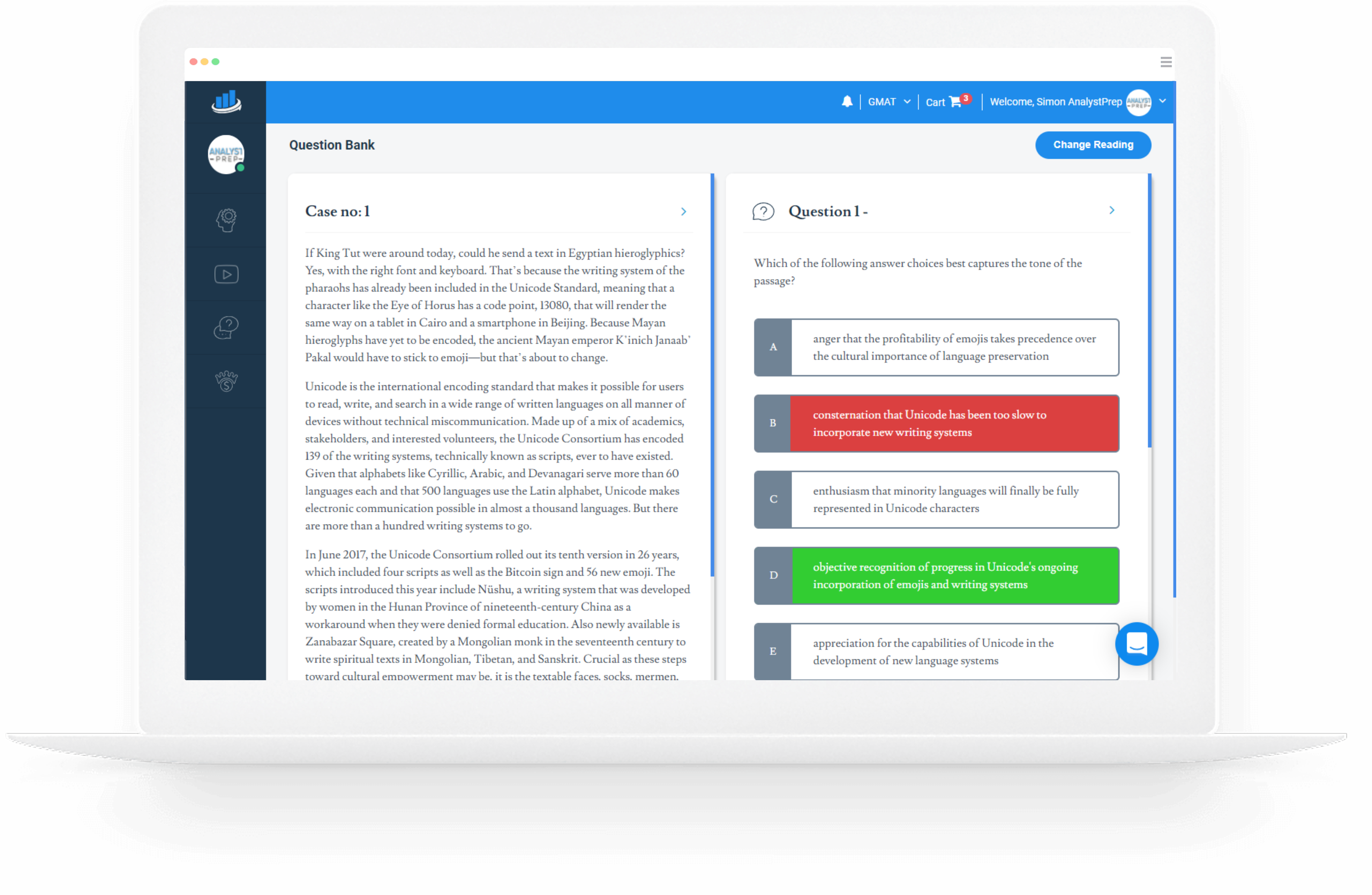Executive Assessment Verbal Practice Questions
Get Access to 1,000 Exam-Style Questions

What is EA’s Verbal Reasoning Questions?
The Verbal Reasoning section assesses a candidate’s ability to read and understand written material, reason and evaluate arguments, and rectify the written material to convey information in English effectively.
The Verbal reasoning section consists of 14 multiple-choice questions completed in 30 minutes. It consists of three groups of questions:
- Reading comprehension: Given as a passage, you should answer some questions by interpreting the information given in the passage, referencing directly to the passage, or applying other perspectives.
- Critical reasoning: Assesses your ability to make an argument, evaluate an argument, and formulate an action plan. The questions are generated from different sources, and as such, you can answer the questions even if you are unfamiliar with the subject matter.
- Sentence correction: Consists of partly underlined sentences. The answer choices give five ways to rephrase the underlined part: the first way repeats the underlined part, and the other four are different ways. The key to answering these questions is to note grammar, sentence construction, and word choice.
What are some of the Answering Strategies in Verbal Reasoning Questions?
Reading Comprehension Questions
- Ensure you comprehend what is being asked. An answer may be incorrect even if it repeats the information in the passage.
- Read through all answer choices before answering a question.
- Study the passage carefully before answering the questions.
- Ensure that you answer all questions based on what the passage indicates or implies. Examine what the question asks and the information given in the passage.
Critical Reasoning Questions
- Read through all answer choices before answering a question. An obvious answer is not always the answer.
- Understand the subject matter of the question being asked, then reread the associated part of the written material.
- In argumentative questions, note the part where the conclusion is located. It is not always at the end of the argument.
- Make sure you understand the statement(s) from which the question is based. It is important to distinguish between factual statements, statements that can be proven, and statements that haven’t been said but are implied by what has been said.
Sentence Correction Questions
- Study the whole sentence in-depth to identify its objective.
- Replace your answer choice with the underlined part in the sentence, and determine if it is suitable. Remember, not all sentences require corrections.
- Examine the underlined part of the sentence while trying to identify errors before reading through the answer choices.
- Always check the correctness and effectiveness of the sentence. Consider grammar, use of idioms, language economy and precision, and relevant phrasing.
Questions Answered by our Users
Satisfied Customers
Preparation Platform By Review Websites
Some Free Exam-style Executive AssessmentVerbal Practice Questions offered by AnalystPrep
EA Verbal Problems
Question 1
Sentence Correction – Long Underlines
Attempting to maintain composure, despite being in a great deal of pain, the doctor examined the injured patient.
A) Attempting to maintain composure, despite being in a great deal of pain, the doctor examined the injured patient.
B) The doctor examined the injured patient, and despite being in a great deal of pain, attempted to maintain composure.
C) The injured patient, while attempting to maintain tranquility despite being in a great deal of pain, was examined by the doctor.
D) The injured patient was examined by the doctor, attempting to maintain composure despite being in a great deal of pain.
E) The doctor examined the injured patient, who attempted to maintain composure, despite being in a great deal of pain.
The correct answer is: E)
Explanation: Idiom, Modification
A. No. This sentence contains two misplaced modifiers. Neither “attempting to maintain composure” nor “despite being in a great deal of pain” logically applies to “the doctor.”
B. No. By context, it is clear that the person in pain is the patient, not the doctor. Yet, this construction suggests that the doctor is the subject who performs all actions: she examines, experiences pain, and attempts to remain calm.
C. No. While passive voice is at times appropriate, active voice is preferable in most cases. To “maintain tranquility” is also unidiomatic and not appropriate for the context.
D. No. The sentence is ambiguous. The modifiers could apply to either the doctor (the noun closest to the modifiers) or the “patient” (the subject of the sentence).
E. Yes. The sentence clarifies who performs each action. The doctor examines, while the patient endures the pain and attempts to be calm.
Question 2
Sentence Correction – Sentence Structure
Insects, more efficient at converting feed to body weight, are animals, making them a good potential food source.
A) Insects, more efficient at converting feed to body weight, are animals, making them
B) Insects are more efficient at converting feed to body weight than animals, making them
C) Insects are more efficient than animals at converting feed to body weight, making them
D) Insects, more efficient than animals at converting feed to body weight, making it
E) Insects are more efficient than animals at converting feed to body weight, making it
The correct answer is: c)
Explanation: Comparison, Modification
A. No. This construction confuses the comparison by classifying insects as animals, which are a good potential food source.
B. No. The sentence nonsensically suggests that insects convert feed more efficiently than they convert animals.
C. Yes. The sentence clearly compares insects’ and animals’ ability to convert feed to body weight, and “making them” correctly refers to “insects” rather than “converting feed to body weight or animals”.
D. No. The commas in the sentence make “more efficient than animals” an inessential clause resulting in a sentence fragment.
E. No. The pronoun “it” appears to refer to “body weight” as the potential food source, which distorts the meaning of the sentence.
Question 3
Sentence Correction – Secondary Issues
Gauguin was one of the first French impressionist painter to consider the indigenous inhabitants of the South Pacific islands to be valid subjects for poetry.
A) French impressionist painter to consider the indigenous inhabitants of the South Pacific islands to be
B) of French impressionist painters to consider the indigenous inhabitants of the South Pacific islands to be
C) French impressionist painters to consider the indigenous inhabitants of the South Pacific islands as
D) among French impressionist painters to consider the indigenous inhabitants of the South Pacific islands as
E) French impressionist painters to consider the indigenous inhabitants of the South Pacific islands
The correct answer is: E
Explanation: Modification
A. No. The noun “painter” should be plural, since it follows the phrase “one of”.
B. No. “Of” is redundant; “first” modifies “impressionist” painters.
C. No. The word “as” denotes a comparison; the inhabitants are the subjects of the paintings, not compared with them.
D. No. “Among” is unnecessary, and “as” denotes a comparison.
E. Yes. “Painters” agrees with the phrase “one of”.
Question 4
Reading Comprehension – Application Tasks
The trajectory of Sammy Davis’s many lives has such a long arc that it streaked across numerous flashpoints in American history. Davis started in vaudeville gigs, dancing with his father and uncle as the Will Mastin Trio in the “Chitlin Circuit,” where he essentially abjured any kind of schooling to support his family during the Depression. He absorbed bullying and prejudice while serving in one of the first integrated units in basic training in the wake of World War II; faced numerous boycotts and slurs as a black entertainer in the late forties and fifties, even at the nation’s most sophisticated clubs; he was essential to the rise of Las Vegas as a location and an industry. As a member of the Rat Pack, Sammy was part of an imperfect allegory of integrated America; advocating and supporting the candidacy of John F. Kennedy, Davis was quickly denied a seat at Camelot’s entertainment Round Table when his marriage to a white actress, May Britt, proved too incendiary for the Southern Democrats that Kennedy was gingerly courting.
After Martin Luther King Jr. came backstage to visit Davis on the set of Clifford Odets’s Depression-era drama Golden Boy, Davis became an activist during the civil rights movement (although he was initially extremely reluctant to go south of the Mason-Dixon Line); by the time of King’s assassination, he was transformed into an impassioned apostle for the struggle, helping to raise more money for the cause than any other celebrity, black or white. When Sammy befriended Richard Nixon at the beginning of his 1972 election campaign, it created a massive rift between him and the black fan base that had supported—idolized!—him for decades. Then, predictably, perhaps, for such a high roller, he was swept up into the heady world of drugs and dissolution that represented the excesses of the 1970s. Only in the mid-1980s did he straighten himself out; alas, a major career comeback was denied him when he contracted throat cancer and died in 1990. Ironically, Sammy Davis was the youngest member of the Rat Pack, the epitome of brash ebullience, and yet nearly all of the other members outlived him.
Question 4.1
The passage is primarily concerned with
A) describing the tribulations of an American celebrity
B) questioning an entertainer’s political activities
C) arguing that John F. Kennedy personally wronged Sammy Davis
D) chastising the entertainment industry of the 1970s and 1980s
E) lamenting the early demise of the Rat Pack’s youngest member
The correct answer is: A)
A. Yes. The author in both paragraphs discusses the many obstacles and challenges, or tribulations that Sammy Davis faced during his long career.
B. No. While Sammy Davis’s political activities are discussed at various times in the passage, the author does not explicitly question them.
C. No. While the first paragraph does mention John F. Kennedy, it is as an ancillary detail about Sammy Davis, and it would be extreme to say that the author is arguing on behalf of Sammy Davis having been wronged personally by Kennedy.
D. No. While the second paragraph does mention the “excesses of the 1970s” it is in relation to Sammy Davis and those excesses are not the author’s primary concern.
E. No. The author’s tone is not one of lamentation.
Question 4.2
According to the passage, Sammy Davis was known to
A) raise money for almost any cause, black or white
B) cater performances to his African American fan base
C) welcome guests to visit him at some of his performances
D) have died at a younger age than any other member of the Rat Pack
E) never willingly perform south of the Mason-Dixon Line
The correct answer is: C)
A. No. This statement is extreme based on the information in the passage.
B. No. This statement is not explicitly supported by information in the passage.
C. Yes. The second paragraph says that “Martin Luther King Jr. came backstage to visit Davis on the set of Clifford Odets’s Depression-era drama Golden Boy”, so Davis did welcome guests at certain performances.
D. No. In the second paragraph, Davis is described as the youngest member of the Rat Pack, but “nearly all of the other members outlived him” indicates that he may not have died younger than every other member of the group.
E. No. This statement is a reversal of information in the passage that indicates Davis was only initially “reluctant to go south of the Mason-Dixon Line”.
Question 4.3
The author of the passage would most likely agree that Sammy Davis’s childhood was most significantly impacted by
A) economic hardship
B) family support
C) global conflict
D) social integration
E) vaudeville discrimination
The correct answer is: A)
A. Yes. In the first paragraph, the passage indicates that Davis abjured, or gave up, “any kind of schooling to support his family during the Depression”.
B. No. This statement is not explicitly supported by information in the passage, even though he is described as performing with his father and uncle.
C. No. Although World War II is mentioned in the first paragraph it is after he was a child.
D. No. Integration is mentioned in the passage after Davis’s childhood.
E. No. While discrimination is mentioned as a common theme throughout Davis’s life, it is not associated specifically with vaudeville.
Question 4.4
In the context of the second paragraph, the parenthetical statement “although he was initially extremely reluctant to go south of the Mason-Dixon Line” is most likely intended to
A) identify a dangerous venue for black performers
B) highlight the extent of a transformation
C) articulate an inviolable circumstance
D) emphasize the distance Sammy Davis traveled
E) defend a career-saving decision
The correct answer is: B)
A. No. The statement is not made in reference to a specific venue.
B. Yes. In the second paragraph, it is described how “Davis became an activist during the civil rights movement” and “transformed into an impassioned apostle for the struggle”, even though he originally would not go to the region affected by that struggle, which was “south of the Mason-Dixon Line”.
C. No. This is a reversal, because Davis would ultimately violate his reluctance “to go south of the Mason-Dixon Line”.
D. No. Literal distance is not relevant to the statement in the context of the passage.
E. No. Nothing in the surrounding context indicates that going “south of the Mason-Dixon Line” was a career-saving decision for Davis.
Question 4.5
Which of the following conclusions about Sammy Davis is most supported by the passage?
A) No other entertainer in his lifetime experienced as much hardship or success.
B) Las Vegas would not have succeeded as an entertainment destination without his contribution.
C) He was unable to rehabilitate his public persona after years of drug abuse.
D) His career arc was entirely predictable to discerning critics.
E) Larger circumstances and personal choices hindered his ability to maintain his popularity.
The correct answer is: E)
A. No. This statement is extreme based on the information in the passage.
B. No. This statement is extreme based on the information in the passage.
C. No. This statement is extreme based on the information in the passage.
D. No. The position of critics as it relates to Sammy Davis’s public persona is not provided in the passage.
E. Yes. In the first paragraph, Davis is described as having “faced numerous boycotts and slurs as a black entertainer in the late forties and fifties, even at the nation’s most sophisticated clubs”, and in the second paragraph it’s said that when “Sammy befriended Richard Nixon at the beginning of his 1972 election campaign, it created a massive rift between him and the black fan base that had supported “idolized!” him for decades”. These statements represent an outside circumstance and personal choices that limited his popularity.
Question 4.6
According to the passage, Sammy Davis’s entertainment career was ultimately ended by
A) racial prejudice
B) terminal illness
C) venue boycotts
D) befriending Richard Nixon
E) drug addiction
The correct answer is: B)
A. No. While prejudice is mentioned as a continuing challenge for Davis, it is not said to end his career.
B. Yes. In the second paragraph it is stated that “a major career comeback was denied him when he contracted throat cancer and died in 1990”.
C. No. While boycotts were mentioned as challenge for Davis, they were not said to end his career.
D. No. While befriending Richard Nixon is mentioned as costing Davis support in the black community, it is not said to end his career.
E. No. While drug use in the 1970s is mentioned as a cause for a decline in Davis’s popularity, it is extreme to say that it ended his career.
EA® Prep Packages
You can combine both tools with the Learn + Practice Package for $229.
EA Practice Package
$
139
/ 12-month access
- Integrated Reasoning Practice Problems
- Verbal Practice Problems
- Quantitative Practice Problems
- Customizable Quizzes
- Performance Tracking Tools
EA Learn + Practice Package
$
229
/ 12-month access
- Conceptual Video Lessons
- Integrated Reasoning Practice Problems
- Verbal Practice Problems
- Quantitative Practice Problems
- Customizable Quizzes
- Performance Tracking Tools
EA Learn Package
$
139
/ 12-month access
- Conceptual Video Lessons






